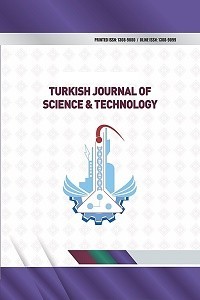Vegetable and Fruit Image Classification with SqueezeNet based Deep Feature Generator
Vegetable and Fruit Image Classification with SqueezeNet based Deep Feature Generator
___
- G.J.H. Grubben, Vegetables, Prota, 2004.
- J.L. Slavin, B. Lloyd, Health benefits of fruits and vegetables, Adv. Nutr. 3 (2012) 506–516.
- J.C. Rickman, C.M. Bruhn, D.M. Barrett, Nutritional comparison of fresh, frozen, and canned fruits and vegetables II. Vitamin A and carotenoids, vitamin E, minerals and fiber, J. Sci. Food Agric. 87 (2007) 1185–1196.
- K. Ikeuchi, Computer vision: A reference guide, Springer, 2021.
- A.I. Khan, S. Al-Habsi, Machine learning in computer vision, Procedia Comput. Sci. 167 (2020) 1444–1451.
- M. Hassaballah, K.M. Hosny, Recent advances in computer vision, Stud. Comput. Intell. 804 (2019).
- J.F.S. Gomes, F.R. Leta, Applications of computer vision techniques in the agriculture and food industry: a review, Eur. Food Res. Technol. 235 (2012) 989–1000.
- D. Wu, D.-W. Sun, Colour measurements by computer vision for food quality control–A review, Trends Food Sci. Technol. 29 (2013) 5–20.
- S. Li, Y. Tian, P. Jiang, Y. Lin, X. Liu, H. Yang, Recent advances in the application of metabolomics for food safety control and food quality analyses, Crit. Rev. Food Sci. Nutr. 61 (2021) 1448–1469.
- S. Gaikwad, Literature Review on Multi-Spectral Imaging for Fruits and Vegetable, Available SSRN 3905180. (2021).
- F. Yuesheng, S. Jian, X. Fuxiang, B. Yang, Z. Xiang, G. Peng, W. Zhengtao, X. Shengqiao, Circular fruit and vegetable classification based on optimized GoogLeNet, IEEE Access. 9 (2021) 113599–113611.
- J.K. Bhavya, B.S. AC, K. Gayithri, B.L. Keerthi, M.Y. MG, THE LITERATURE SURVEY ON INTRA CLASS FRUITS AND VEGETABLE RECOGNITION SYSTEM USING DEEP LEARNING, (n.d.).
- R.S. Latha, G.R. Sreekanth, R.C. Suganthe, M. Geetha, N. Swathi, S. Vaishnavi, P. Sonasri, Automatic Fruit Detection System using Multilayer Deep Convolution Neural Network, in: 2021 Int. Conf. Comput. Commun. Informatics, IEEE, 2021: pp. 1–5.
- M.I. Ahmed, S.M. Mamun, A.U.Z. Asif, DCNN-Based Vegetable Image Classification Using Transfer Learning: A Comparative Study, in: 2021 5th Int. Conf. Comput. Commun. Signal Process., IEEE, 2021: pp. 235–243.
- O. Patil, Classification of Vegetables using TensorFlow, Int. J. Res. Appl. Sci. Eng. Technol. 6 (2018) 2926–2934. https://doi.org/10.22214/ijraset.2018.4488.
- H. Kuang, C. Liu, L.L.H. Chan, H. Yan, Multi-class fruit detection based on image region selection and improved object proposals, Neurocomputing. 283 (2018) 241–255.
- Z. Yuhui, C. Mengyao, C. Yuefen, L. Zhaoqian, L. Yao, L. Kedi, An Automatic Recognition Method of Fruits and Vegetables Based on Depthwise Separable Convolution Neural Network, J. Phys. Conf. Ser. 1871 (2021). https://doi.org/10.1088/1742-6596/1871/1/012075.
- J.L. Joseph, V.A. Kumar, S.P. Mathew, Fruit Classification Using Deep Learning, in: Innov. Electr. Electron. Eng., Springer, 2021: pp. 807–817.
- F.N. Iandola, S. Han, M.W. Moskewicz, K. Ashraf, W.J. Dally, K. Keutzer, SqueezeNet: AlexNet-level accuracy with 50x fewer parameters and< 0.5 MB model size, ArXiv Prepr. ArXiv1602.07360. (2016).
- B. Koonce, SqueezeNet, in: Convolutional Neural Networks with Swift Tensorflow, Springer, 2021: pp. 73–85.
- T. Tuncer, E. Akbal, S. Dogan, Multileveled ternary pattern and iterative ReliefF based bird sound classification, Appl. Acoust. 176 (2021) 107866. https://doi.org/10.1016/j.apacoust.2020.107866.
- P. Xanthopoulos, P.M. Pardalos, T.B. Trafalis, Linear discriminant analysis, in: Robust Data Min., Springer, 2013: pp. 27–33.
- M.I. Ahmed, Vegetable Image Dataset, (2022). https://www.kaggle.com/misrakahmed/vegetable-image-dataset.
- D.M.W. Powers, Evaluation: from precision, recall and F-measure to ROC, informedness, markedness and correlation, (2020). https://arxiv.org/abs/2010.16061 (accessed November 15, 2021).
- ISSN: 1308-9080
- Başlangıç: 2009
- Yayıncı: Fırat Üniversitesi
Vegetable and Fruit Image Classification with SqueezeNet based Deep Feature Generator
Ezgi GÜRGENÇ, Aydin DİKİCİ, Fehmi ASLAN
MUSIC Based Microwave Imaging of Nonlinear Point-Like Scatterers
A Lung Sound Classification System Based on Data Augmenting Using ELM-Wavelet-AE
Berna ARI, Ömer Faruk ALÇİN, Abdülkadir ŞENGÜR
Mobile Robot Indoor Localization Using Color-Coded Beacons and a Depth Camera
Mawj MOHAMMED BASHEER, Mehmet ÇAVAŞ, Mohammed QASIM
A Substitution-Box Structure Based on Solar Panel Data
Esin TURAN, Mustafa Kemal ÖZDEMİR, Barış KARAKAYA, Fatih ÖZKAYNAK
Control Based on Feedback Linearization of a Mobile Manipulator Robot for Trajectory Tracking
